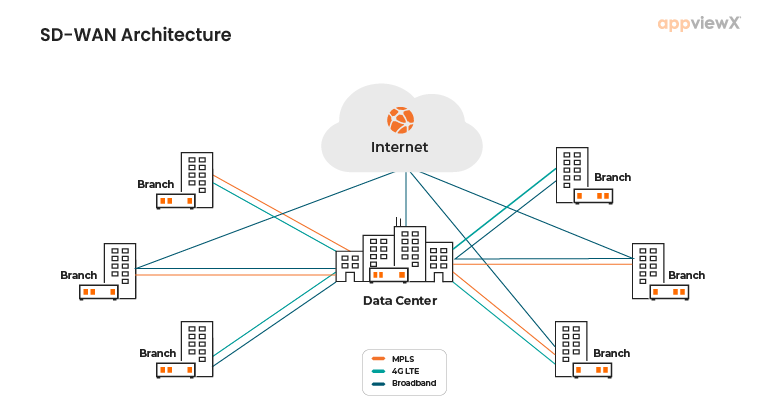5 Typical Misconceptions About SD-WAN Technology Corrected
If your business operates over multiple branches, then you have probably come across software-defined wide area networks (SD-WANs) before.
Their primary purpose is to solve issues that arise from a business that’s spread across geographical areas. A WAN (wide area network) can be used to send data between the branches of a business by connecting them to one another, to headquarters, or to a centralized data center. It’s incredibly useful.
An SD-WAN allows businesses to leverage different types of connections between locations (internet, 4G, multiprotocol label switching) to share data and use cloud-based applications.
It can require a lot of costly hardware that requires maintenance and plenty of physical space. With an SD-WAN, you can allow the software to take over data transfers. This allows for smoother and more reliable communication and data transfer between branches.
If you are considering setting up an SD-WAN, you’ll should know of some common myths and misconceptions surrounding them and what they can do for your business.
1. SD-WANs Replace Other Network Components
Although versatile, SD-WANs don’t replace all existing technology.
Multiprotocol label switching (MPLS) is a method of pre-determining how ‘packets’ of data are transferred in a network. It’s the basis of establishing a WAN, directing data packets from one point in the system to another.
While it’s technically possible to replace MPLS infrastructure with broadband links, this is not universal. What the internet can achieve is limited in this system, particularly across a highly complex network.
For example, imagine that you are a sales representative making use of a new cloud-based PBX to be more efficient. You deliver a pre-recorded message to a prospect’s voicemail, saving you minutes on each phone call.
You don’t automate the whole process, though. You still make the call. You still speak to a prospect when they answer your call. Like voicemail drop, SD-WANs exist to improve what’s already there.
One of the major reasons that this is the case is security. While SD-WANs are great for transferring data between branches and connecting with the cloud, MPLS still remains the most secure component of an area network because they’re specific to the business or organization.
Continuing with the example of a sales representative, imagine that you are recording calls for a training exercise.

Call recording disclosure is more important than ever, since customer conversations will now be shared on the cloud instead of being routed through a data center. These calls will be shared with the whole of the sales team using your new SD-WAN.
A cloud-based system is convenient for a team across multiple locations and is great for team training. But you will need to bear in mind any privacy implications if you are storing any customer data and sharing it within a cloud application.
2. SD-WANs are Always a Money-Saver
When adopting any new technology, one of the things that you’re likely to be concerned about is whether it will save money for your business.
SD-WANs can be a cost-saver in the long run because they improve reliability and save staffing hours. Costs could be reduced by up to 54% in comparison to a WAN reliant on only MPLS infrastructure. This technology is also software reliant, meaning you can avoid purchasing expensive hardware necessary for similar programs.
However, they are not always the cheapest options. Don’t assume that all of your hardware can be replaced with broadband alternatives. Particularly as the business grows and spreads out over a wider area. You will need to work with your existing WAN to roll out an SD-WAN effectively.
This technology can help to protect your business against the demand for bandwidth within an organization, but broadband cannot always replace MPLS networks.

3. All SD-WAN Services are Created Equal
There are actually three types of SD-WAN architecture. Knowing the difference between them will help you to choose the best type for your business and avoid extra costs or delays.
Which type of SD-WAN service that you use will depend on what type of business you have and the complexity of your network.
For example, MPLS-based involves having an appliance at each customer location. It’s great for businesses operating over a geographically wide area, an outbound call center, for instance.
Premises-based SD-WAN, on the other hand, is most useful to local or smaller businesses. It involves having an on-site piece of hardware that controls the program.
Internet-based SD-WANs involve using a public internet connection. There are still appliances at each location. With 5G connections on the rise, there is an opportunity for SD-WANs to make use of this new link between locations.
How do you make sure that you have chosen wisely?
Tracking QA metrics in Agile should be one of your key focuses when it comes to ensuring that your SD-WAN is the correct type for your business.
It might sound complicated, but all it involves is testing your software according to Agile principles. Consider quality, communication, and a flexible approach when using the Agile testing method.
Specifically, Quality Assurance (QA) testing will work to ensure that your system is consistently working as it should, to the best of its ability. With Agile, developers and testers work together instead of apart, which improves efficiency. It also helps to promote understanding of potential problems with the system within your team.
4. You Should Always Set Up Your Own SD-WAN
Because SD-WANs can make use of existing connections between branches as well as the cloud, you might assume that programing your own SD-WAN is the way forward.
However, building a network of this complexity, although rewarding, requires expertise which most businesses don’t have in-house.
Managed SD-WANs are obviously more expensive than DIY, but they are often more straightforward for your business. If you don’t have an IT department full of telecommunications experts, then setting up your own SD-WAN is likely to cause you problems in terms of costs and efficiency.

However, once your SD-WAN has been set up, there are plenty of things that you can do to ensure proper functionality.
Exploratory testing is a great way to ensure that your network is functioning as it should and will identify any bugs that may have been missed during setup. It allows the tester to test an application without being limited by pre-written instructions.
Because SD-WANs are a relatively new piece of technology to many, this method of testing is always beneficial to work out any problems early on. Sharing potentially sensitive data, depending on the nature of your business, between locations and on cloud-based systems means that issues need to be detected early.
5. SD-WANs are Only for Multinationals
This is a hugely useful piece of equipment. If, for example, your small business call center is just getting off the ground or you are looking to scale up, software-defined programs will be just as useful to you as to a multinational corporation.
It can be an integral part of a tech stack for startups, as starting with an SD-WAN from the beginning will help you get to grips with the technology and communicate with your team.
As your business grows to multiple branches, you will then have the infrastructure in place to send data between locations easily without the need to ever purchase lots of expensive hardware.
Another innovative way of maintaining the network is through hyperautomation. Perfect for programmers in any size of business, this process will help to maintain workflow in a software-defined system.
What is hyperautomation?
Hyperautomation combines RPA development with AI programs to scan a software infrastructure or system for potential automation opportunities. It is extremely helpful for the agile testing methodology.
For example, say your business provides phone systems for technology companies. Part of your service is a feature that allows clients to store customer call data in a database. You might consider writing a program that looks for opportunities to automate the logging of call data.

You can improve your provision of phone system features by automating repetitive tasks. Here, you can apply automation testing from scratch. These updates can be shared using an SD-WAN setup and subsequently applied to every aspect of your service. This is a particularly useful feature for startups launching technical, innovative products or services.
Considering an SD-WAN?
If you’re thinking about incorporating this technology into your business, you’ll need to do some research into a smooth transition and how to effectively train your team in using it.
The rise of cloud-based equipment means that traditional wide area networks are being challenged. Businesses working over wide areas transferring huge amounts of data can cause delays when using broadband or MPLS-only systems.
The SD-WAN setup sidesteps these issues by allowing businesses to tap into multiple links between locations at once.
Business & Finance Articles on Business 2 Community
(21)

